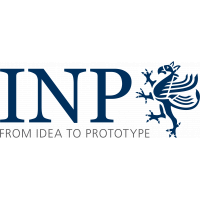Laser absorption spectroscopy (LAS) was applied to investigate a low pressure DC-pulsed discharge in N2-H2 gas mixtures with addition of CH4 or O2. The discharge was maintained in an industrial-scale, active screen plasma nitrocarburizing (ASPNC) reactor with a steel active screen (AS). Spectroscopic lines of CH4, NH3, HCN, CO and H2O were recorded. The dataset contains the species densities for different gas mixtures.
| Field | Value |
|---|---|
| Group | |
| Authors | |
| Release Date | 2023-07-21 |
| Identifier | 7ce353e7-8fd2-4545-931e-289850a1f3a6 |
| Permanent Identifier (DOI) | |
| Permanent Identifier (URI) | |
| Plasma Source Application | |
| Plasma Source Specification | |
| Plasma Source Properties | The low-pressure DC-pulsed discharge was maintained in an industrial-scale, active screen plasma nitrocarburizing (ASPNC) reactor with a steel active screen. The reactor is cylindrical with an inner diameter of 1 m and a volume of approximately 1 m^3. The reactor walls consist of two parts. The first part is a massive steel wall with an internal water-cooling and vacuum sealing. The second part is a heat shield consisting of four layers of steel sheets, which are fixed to the inner water-cooled wall at approximately the same distance from each other and adding about 5 cm to the wall thickness. The temperature of the outer wall of the reactor maintains close to room temperature even after 8 hours of operation. |
| Plasma Source Procedure | A double mesh of construction steel (1.0038) serves as an AS with a diameter of 0.8 m and a height of 0.75 m at cathodic potential with a pulsed DC high voltage of 1 kHz frequency at a 60 % duty cycle. An assembly of interconnected steel rings was placed in the center of the reactor as a model probe to simulate a biased workpiece and provide a diagnostics path for the laser beam. A thermoelectric sensor (TE) was attached to the model probe (see figure 1) to maintain the workload temperature at 813 K (540 °C), controlled by the AS power. During the spectroscopic measurements, the AS power was about 7.3 kW and the bias power was 1.25 kW. |
| Plasma Medium Name | |
| Plasma Medium Properties | A total flow of 80 slh and a pressure of 3 mbar were maintained during the measurements. |
| Plasma Medium Procedure | Three sets of measurements were carried out over two days. Each day started with a pre-heating phase in a N2-H2 gas mixture, with the AS at full power and a step-wise increase of the bias power. A proportional-integral-derivative (PID) controller regulated the AS power to achieve fast stabilization of the process temperature. Two measurements sets were performed in one day and one set on the next day. The reactor was kept closed and maintained at low pressure during the entire experiment, including the break between measurement sets 2 and 3. Each set of measurements consisted of a conditioning phase and a cleaning phase. The conditioning phase lasted about 1 hour with a CH4 flow of 8 slh (10% of total flow). The cleaning phase had a duration of about 3 hours without CH4 flow. In sets 1 and 2, a small O2 flow of 4.8 slh (6%) and 1.6 slh (2%) was added, respectively. In set 1, the O2 flow was interrupted for 8 minutes due to a failure of the mass flow controller. |
| Plasma Diagnostics Name | |
| Plasma Diagnostics Properties | Two external-cavity quantum cascade lasers (DRS Daylight Solutions Inc., San Diego, CA, USA; MHF-21047 and MHF-41074) were used for monitoring the plasma chemical composition. The lasers were co-aligned using a flipping mirror for laser selection. Two beam splitters divided the beam path into three channels to record the etalon (3 inch, Ge) and reference gas spectrum simultaneously with the spectrum in the discharge. One laser was tuned between two spectral windows and the second laser was used for an additional spectral window. |
| Plasma Diagnostics Procedure | Spectroscopic lines of CH4, NH3, HCN, CO and H2O were recorded for different feed gas compositions. Five scans per spectral window were recorded for each measurement point and then calibrated separately. The scatter of the resulting data was used to estimate the error bars while also giving an uncertainty related to the determination of the detector baseline due to the limited bandwidth of the detector. |
| Language | English |
| License | |
| Public Access Level | Public |
| Contact Name | Andrei Pipa |
| Contact Email |
Data and Resources
- Laser absorption spectroscopy for plasma-assisted thermochemical treatment - spectral window acsv
Densities of CH4 and HCN versus time in spectral window a. The time-...
Preview Download - Laser absorption spectroscopy for plasma-assisted thermochemical treatment - spectral window bcsv
Densities of NH3, HCN and H2O versus time in spectral window b. The time-...
Preview Download - Laser absorption spectroscopy for plasma-assisted thermochemical treatment - spectral window ccsv
Density of CO versus time in spectral window c. The time-dependent process...
Preview Download - Laser absorption spectroscopy for plasma-assisted thermochemical treatment - all data in xlsx formatexcel
Densities of all measured species versus time combined in an Excel table....
Download - Laser absorption spectroscopy for plasma-assisted thermochemical treatment - all data in pdf formatpdf
Densities of all measured species versus time combined in a pdf file.
Download - Laser absorption spectroscopy for plasma-assisted thermochemical treatment - metadata logcsv
Logging of process parameters versus time.
Preview Download

![[Open Data]](https://assets.okfn.org/images/ok_buttons/od_80x15_blue.png)